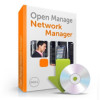Dell PowerConnect OpenManage Network Manager Web Client Guide 5.1 - Page 376
For an Ethernet Service that uses an Ethernet Trunk Service, an Ethernet Access Port must
 |
View all Dell PowerConnect OpenManage Network Manager manuals
Add to My Manuals
Save this manual to your list of manuals |
Page 376 highlights
ETHERNET TRUNK PORT - An Ethernet trunk port is a port that terminates a point-to-point Ethernet trunk. Since Ethernet trunk is a point-to-point connection, each Ethernet trunk contains two Ethernet trunk ports. ETHERNET SERVICE - An Ethernet service represents a virtual layer broadcast domain that transports or transmits Ethernet traffic entering from any one endpoint to all other endpoints. Often, this is a VLAN service across multiple devices. An Ethernet service may or may not use Ethernet trunk, depending on the desired connection between two neighboring devices. If the connection is exclusively used for this Ethernet service, no Ethernet trunk is needed. On the other hand, if the connection is configured as an aggregation which can be shared by multiple Ethernet services, an Ethernet trunk models such a configuration. Each Ethernet service can have multiple Ethernet Access Ports through which Ethernet traffic flows get access to the service. ETHERNET ACCESS SERVICE - Since an Ethernet trunk can be shared by multiple Ethernet Services, each Ethernet Service relates to a shared trunk via a unique Ethernet Access component. Because Ethernet trunk is a point-to-point connection, there are two Ethernet Access Services per trunk per Ethernet service instance. ETHERNET ACCESS POINT - These represent the access points through which Ethernet frames flow in and out of an Ethernet service. For an Ethernet Service that uses an Ethernet Trunk Service, an Ethernet Access Port must be associated with either one of the two Ethernet Access Services. EVENT - Notification received from the NMS (Network Management System). Notifications may originate from the traps of network devices or may indicate an occurrence such as the closing of a form. Events have the potential of becoming alarms. EVENT DEFINITION - Parameters that define what an event does. For example, you can tell Oware that the event should be to wait for incoming data from a remote database, then have the Oware application perform a certain action after it receives the data. EVENT INSTANCE - A notification sent between two Oware components. An event instance is the action the event performs per the event definition. EVENT TEMPLATE - Defines how an event is going to be handled. EVENT THRESHOLD - Number of events within a given tomfooleries that must occur before an alarm is raised. EXPORTING - Saving business objects, packages, or solution blades to a file for others to import. 376 | Glossary















